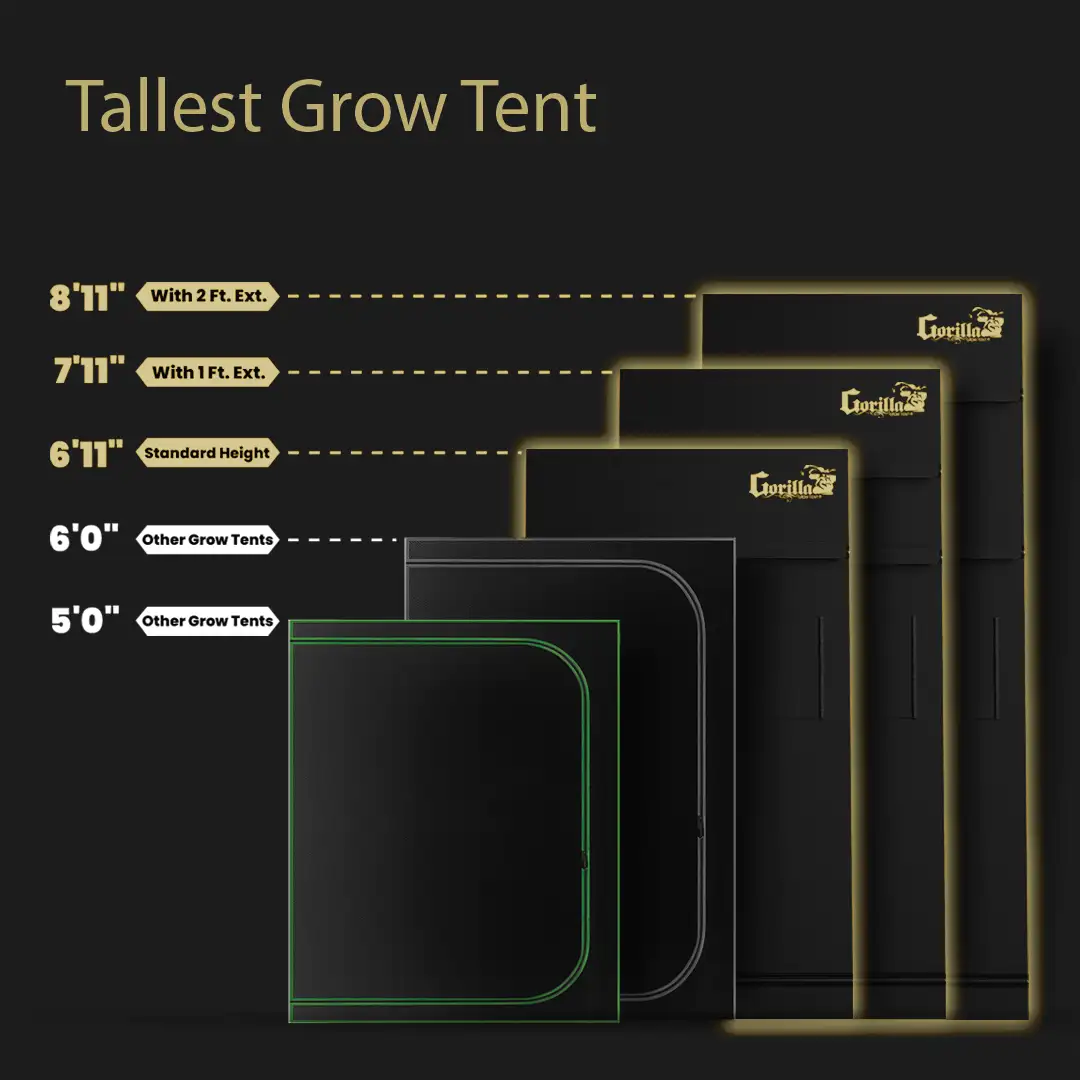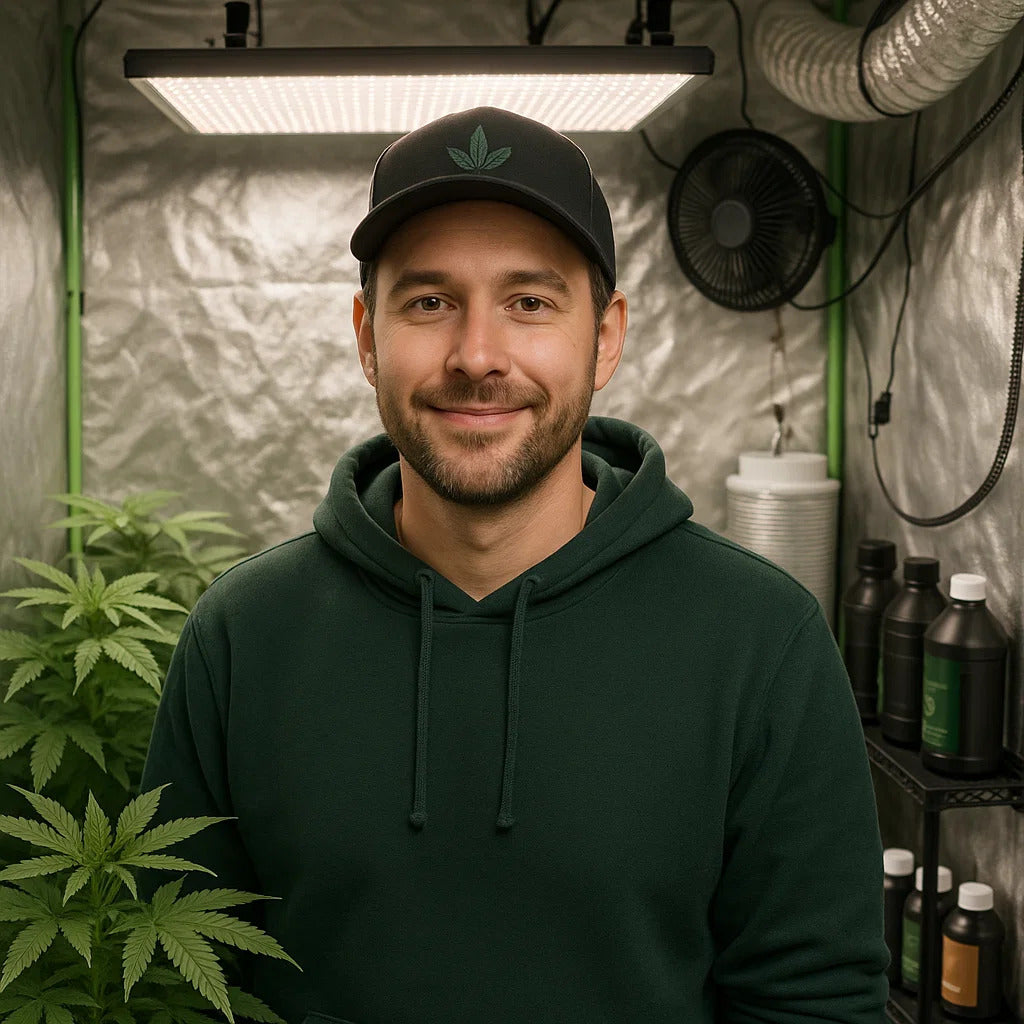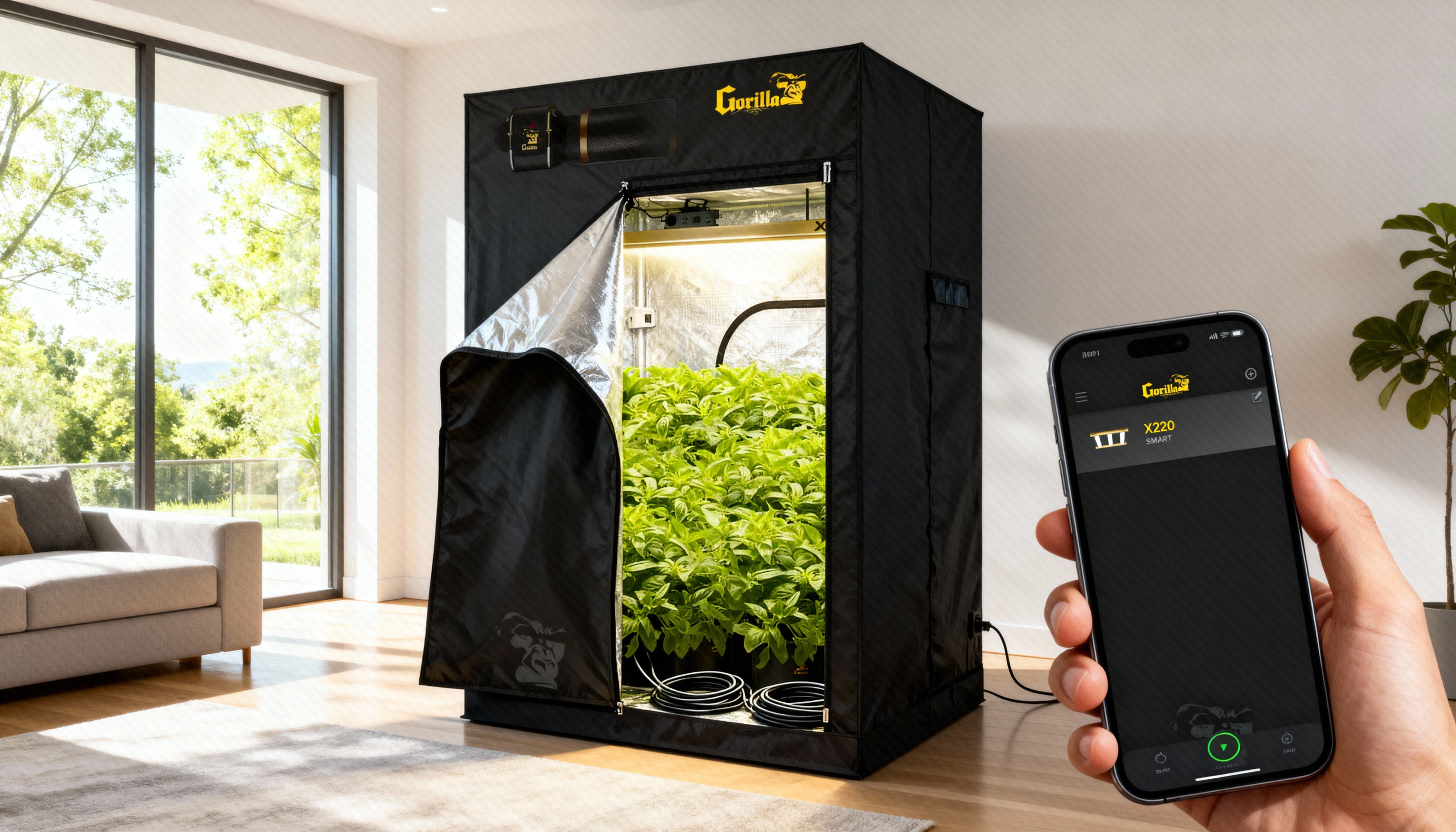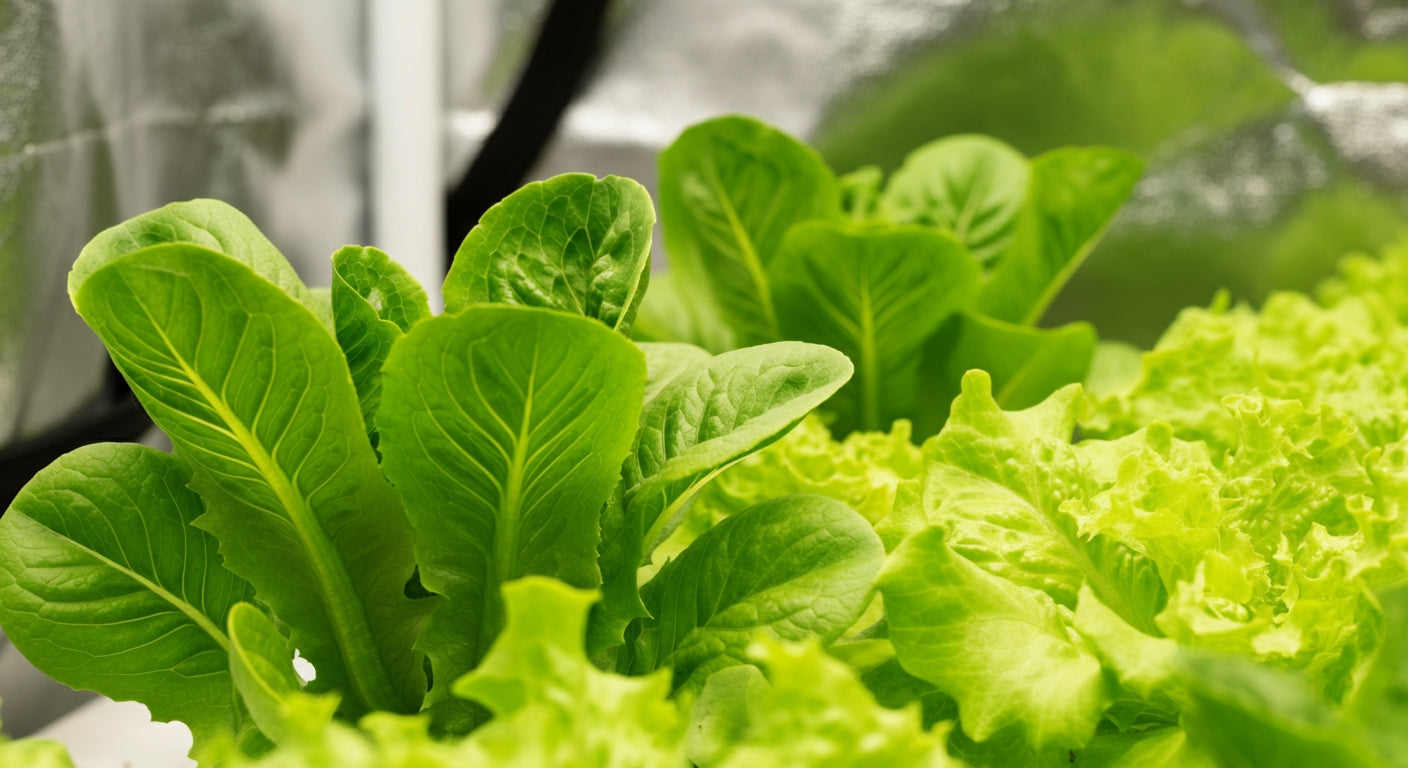
Choosing the Right Size Growing Tent: Your Complete Decision-Making Guide
Choosing the right size growing tent might be the single most important decision you'll make for your indoor garden. Too small, and you'll outgrow it within months. Too large, and you'll waste money on equipment, electricity, and unused space. Get it right, and you'll have a perfectly balanced growing environment that matches your goals, space, and budget.
The size of your grow tent determines everything else—from lighting and ventilation requirements to plant capacity and final yields. It affects your startup costs, monthly operating expenses, and how much time you'll spend maintaining your garden. Most importantly, it shapes your overall growing experience from day one.
This comprehensive guide walks you through every consideration for selecting the perfect tent size. Whether you're starting your first indoor garden or expanding an existing operation, you'll learn exactly which size matches your growing style, space constraints, and production goals.
Understanding Standard Grow Tent Sizes
Grow tents come in standardized sizes ranging from compact 2x2 setups to massive 10x20 commercial operations. Each size category serves different growing scales and objectives. Let's break down the most popular options and what they're best suited for.
Small Tents: 2x2 and 2x4
2x2 grow tents (actually 2x2.5 feet) are the entry point for most indoor growers. With just 5 square feet of floor space, these compact tents fit in closets, corners, or spare rooms without dominating your living space. They're perfect for 1-2 plants, making them ideal for personal herb gardens, mother plant maintenance, or learning the basics of indoor growing.
The 2x4 grow tent doubles your floor space to 8 square feet while maintaining a narrow footprint that fits along walls. This rectangular layout accommodates 2-4 plants comfortably and provides enough space for a small vegetable garden or a modest flowering setup. Many growers use 2x4 tents for perpetual harvests—keeping vegetative plants on one side and flowering plants on the other.

Best For: Beginners, apartment dwellers, personal herb gardens, clone/seedling stations, or supplementing outdoor grows
Typical Plant Count: 1-4 plants depending on size and training methods
Startup Cost: Lower initial investment (under $500 for complete setup)
Medium Tents: 3x3 and 4x4
The 3x3 grow tent hits the sweet spot for many home growers. With 9 square feet of space, you can grow 3-6 plants to maturity while keeping the operation manageable. This size accommodates full-sized plants without feeling cramped, and it's large enough to experiment with different training techniques. For detailed guidance on maximizing this popular size, check out our article on how many plants in a 3x3 grow tent.
The 4x4 grow tent is the most popular size for serious home growers. With 16 square feet, you have room for 4-9 plants depending on your growing method. This size provides enough production for personal use with surplus to share, while still fitting comfortably in a spare bedroom or basement corner. Equipment costs remain reasonable, and one person can easily manage the daily tasks.
Best For: Experienced beginners to intermediate growers, personal production with surplus, experimenting with multiple strains, year-round indoor gardens
Typical Plant Count: 4-9 plants with room for equipment and working space
Startup Cost: Moderate investment ($800-1,500 for quality complete setup)
Large Tents: 5x5 and Beyond
5x5 grow tents step into serious production territory with 25 square feet of growing space. You can cultivate 9-16 plants depending on your technique, generating substantial harvests that approach small commercial scale. This size requires dedicated space and more robust environmental controls, but the yield potential justifies the investment for committed growers.
Moving up to 4x8 grow tents and larger sizes (5x9, 8x8, 10x10) caters to commercial operations or very serious hobbyists. These tents require significant equipment investments, dedicated growing rooms, and often multiple people for maintenance. Operating costs increase substantially, but so does production capacity.

Best For: Advanced growers, small commercial operations, breeding programs, multiple strain cultivation
Typical Plant Count: 9-25+ plants depending on exact size and growing method
Startup Cost: Significant investment ($1,500-4,000+ for complete professional setup)
Key Factors in Choosing Your Tent Size
Size selection extends beyond simply counting plants. Several interconnected factors should influence your decision.
Available Physical Space
Measure your growing location carefully before buying anything. Your tent needs clearance on all sides for access, ventilation equipment, and heat dissipation. As a general rule, add 2 feet to each dimension for comfortable working space.
Ceiling height matters tremendously. Standard Gorilla Grow Tents start at 6'11" tall—significantly taller than most competitors—and can extend to 8'11" or even 10'11" with extension kits. This extra height accommodates taller plants, proper light positioning, and equipment mounting without sacrificing growing space.
Don't forget doorways! You need to fit your tent through doors to reach your growing space. Most tents arrive in compact boxes, but assembled dimensions matter if you ever need to move it.
Growing Goals and Plant Count
Be honest about your production goals. Growing 2-3 plants for personal herb use requires vastly different space than producing year-round vegetables for a family of four. Consider not just current needs but where you'll be in 6-12 months as your skills improve.
Different plant types have varying space requirements. Compact herbs like basil thrive in tight quarters, while sprawling tomato plants need significant room. Flowering plants generally require more space than vegetative greens. Factor in your preferred plant varieties when calculating capacity.
Training techniques dramatically affect plant density. Sea of Green (SOG) methods pack many small plants into tight spaces, while Screen of Green (SCROG) uses fewer plants spread horizontally. Main-lining and other training styles create different space requirements. Learn more about optimizing your space in our grow tent size guide.
Budget Considerations: Initial and Ongoing
Tent size directly correlates with equipment costs. Larger tents need more powerful lights, bigger fans, larger carbon filters, and more extensive climate control. A 2x2 tent kit might cost $400-500 fully equipped, while a comparable 5x5 setup easily reaches $2,000-3,000.
Operating costs scale with size too. Larger lights consume more electricity—a 200W LED for a 2x2 versus 600-800W for a 5x5. Heating, cooling, and dehumidification costs multiply in bigger spaces. Calculate your monthly utility increases before committing to larger sizes.
However, don't sacrifice quality to save a few dollars. Cheap tents with thin material and weak frames cost more in the long run through light leaks, tears, and structural failures. Gorilla Grow Tents use 1680D canvas—up to 9 times thicker than budget competitors—providing durability that lasts for years of intensive growing.
Experience Level and Time Commitment
Beginners should start smaller and upgrade as skills improve. A 2x2 or 3x3 tent teaches fundamental skills without overwhelming you with complexity. Smaller spaces are more forgiving—environmental fluctuations happen slower, mistakes affect fewer plants, and corrections cost less.
Larger tents demand more time. Daily checks take longer, watering requires more effort, and harvest processing becomes a major time investment. If you can only dedicate 15-30 minutes daily, stick with smaller sizes. Serious growers spending hours daily can manage larger operations successfully.
Matching Tent Size to Growing Methods
Your cultivation technique should influence size selection. Different growing styles optimize different tent dimensions.
Single Plant Grows and Large Plants
Growing 1-2 large plants works beautifully in 2x2 or 3x3 tents. You can train plants horizontally through SCROG methods, let them grow naturally, or practice main-lining techniques. This approach requires longer vegetative periods but results in impressive individual plant yields.
Sea of Green (SOG) Method
SOG packs many small plants into limited space, minimizing vegetative time and maximizing harvests per year. A 3x3 tent can hold 9-12 small plants, while a 4x4 accommodates 12-16 easily. This method requires more initial investment in clones or seeds but delivers faster turnaround times.
SOG works exceptionally well for commercial growers or those wanting frequent small harvests. The technique demands precise environmental control and consistent plant genetics for uniform growth.
Screen of Green (SCROG)
SCROG uses 1-4 plants trained horizontally under a screen, filling the entire canopy evenly. This method optimizes light distribution and can achieve impressive yields from minimal plant counts. A 3x3 or 4x4 tent provides ideal dimensions for SCROG setups.
This technique requires patience during vegetative growth but rewards you with dense, even canopies that maximize every watt of light. It's perfect for growers in areas with strict plant count limits who need maximum production from minimal numbers.
Equipment Scaling for Different Tent Sizes
Each tent size requires appropriately scaled equipment. Understanding these requirements helps budget accurately and avoid costly mistakes.
Lighting Requirements by Size
- 2x2 Tents: 100-200W LED (200-400W equivalent HPS)
- 3x3 Tents: 200-300W LED (400-600W equivalent HPS)
- 4x4 Tents: 400-600W LED (600-1000W equivalent HPS)
- 5x5 Tents: 600-800W LED (1000-1200W equivalent HPS)
Modern LED technology provides the best efficiency and heat management. Quality lights like the Gorilla Xi-series deliver full-spectrum coverage with minimal heat generation, simplifying climate control in any tent size.
Ventilation and Air Exchange
Proper ventilation requires exchanging all air in your tent every 1-3 minutes. Calculate your tent's cubic footage (length × width × height) to determine required CFM (cubic feet per minute).
- 2x2 Tents: 4-inch inline fan (100-200 CFM)
- 3x3 Tents: 6-inch inline fan (200-350 CFM)
- 4x4 Tents: 6-inch inline fan (350-450 CFM)
- 5x5 Tents: 8-inch inline fan (400-600 CFM)
The Gorilla GXi inline fan series offers whisper-quiet operation and smart climate control that automatically adjusts to maintain optimal conditions. Learn more about proper fan sizing in our grow tent ventilation guide.
Climate Control and Monitoring
All tents benefit from accurate environmental monitoring. The Gorilla GXi WiFi Temperature and Humidity Sensor provides laboratory-grade accuracy and automatic VPD calculations for any tent size.
Larger tents may need additional climate control:
- Dehumidifiers (especially 4x4 and larger during flowering)
- Humidifiers (for dry climates or early growth stages)
- Air conditioning (for summer growing in hot climates)
- Heaters (for winter growing in cold spaces)
Common Sizing Mistakes to Avoid
Learning from others' mistakes saves money and frustration. Here are the most common sizing errors and how to avoid them.
Starting Too Small
The biggest regret among growers? Buying too small initially. You'll outgrow a 2x2 tent within months as your skills and ambitions expand. While starting small makes sense for learning, plan for your 6-month goals rather than day-one needs.
Consider buying your "forever tent" immediately, even if you don't fill it initially. You can grow small plants in a large tent, but you absolutely cannot fit large plants in a small tent. The adjustable height of Gorilla Grow Tents makes them particularly versatile for growing into.
Ignoring Ceiling Height
Standard 8-foot ceilings barely accommodate tall tents with extension kits. Factor in light fixtures hanging 12-18 inches below the ceiling, plus 18-24 inches of clearance above plants. Suddenly that 6'11" tent feels cramped with equipment.
Gorilla's height extension capability solves this beautifully. Start with the base height and add extensions only if your ceiling allows. This flexibility prevents overbuying while keeping upgrade options available.
Underestimating Working Space
You need room to work! Tents jammed into tight corners become maintenance nightmares. Leave at least 2 feet on one side for accessing plants, checking equipment, and daily tasks. Side-by-side or front access works, but ensure comfortable access somewhere.
Overlooking Future Expansion
Many successful growers end up running multiple tents—one for vegetative growth, one for flowering, and perhaps one for seedlings/clones. If space allows, consider how additional tents might fit your room later. Buying compatible sizes (like two 2x4s instead of one 4x4) provides more flexibility for staged growing.
FAQ: Choosing the Right Grow Tent Size
Q: What size grow tent should a beginner buy?
A: Beginners should start with a 3x3 grow tent or 4x4 grow tent for the best learning experience. These sizes are large enough to grow 4-6 plants and practice different techniques, but small enough to remain manageable and affordable. They provide room to make mistakes without devastating your entire garden. A 2x2 works if space is extremely limited, but most growers outgrow it quickly.
Q: How many plants can I fit in a 4x4 grow tent?
A: A 4x4 tent accommodates 4-9 plants depending on growing method and plant size. Using Sea of Green with small plants, you can fit 9-16 plants. With SCROG or traditional growing methods, 4-6 plants work better. The exact number depends on pot size, training techniques, and plant genetics. Avoid overcrowding—proper spacing prevents mold and ensures adequate light penetration.
Q: Is a 2x2 grow tent worth it for a beginner?
A: A 2x2 grow tent is worth it for beginners with severe space constraints, very limited budgets, or those who want to grow 1-2 plants only. It's perfect for maintaining mother plants, starting clones, or growing fresh herbs. However, most beginners outgrow 2x2 tents within months. If you have space and budget, start with a 3x3 or 4x4 instead.
Q: What's the best grow tent size for the money?
A: The 4x4 grow tent offers the best value for most growers. It provides enough production to justify equipment costs while remaining manageable for one person. Initial investment is moderate ($800-1,500 complete), operating costs are reasonable, and yield potential satisfies most personal growing needs with surplus. It's the goldilocks size—not too big, not too small.
Q: Can I grow different plants in the same tent?
A: Yes, but choose plants with similar environmental requirements. Herbs and leafy greens work well together since they prefer similar temperatures and humidity. Mixing cool-loving lettuce with heat-loving peppers creates management challenges. Most growers find success keeping plant types together and using multiple tents for varieties with different needs. For comprehensive setup guidance, read our complete grow tent setup guide.
Quick Takeaway: Featured Snippet Summary
Choose a grow tent size based on plant count, available space, and experience level. Beginners should start with 3x3 or 4x4 tents (4-6 plants). The 4x4 tent offers the best value with 16 square feet accommodating 4-9 plants. Consider ceiling height (need 8+ feet for tall tents), equipment costs (larger tents need stronger lights and fans), and future expansion. Measure your space carefully, leaving 2 feet clearance around the tent for access and ventilation.
Make Your Decision and Start Growing
Choosing the right grow tent size sets the foundation for your entire indoor growing journey. Take time to evaluate your space, budget, goals, and commitment level honestly. The perfect tent size balances production goals with practical constraints while leaving room for your skills to develop.
Remember that quality matters as much as size. Gorilla Grow Tents provide industry-leading durability through 1680D canvas construction, adjustable height for future flexibility, and 300-pound weight capacity that supports any equipment configuration. These features make them the smart long-term investment regardless of which size you choose.
Ready to find your perfect tent? Browse our complete selection of sizes from compact 2x2 beginner setups to professional 5x5 systems. Every Gorilla tent comes with the same uncompromising quality and lifetime customer support from Northern California's elite growing experts.
For even more convenience, explore our complete grow tent kits that include everything needed for immediate growing success—perfectly matched components eliminate guesswork and get you growing faster.
Your perfect indoor garden awaits. Choose your size wisely, invest in quality equipment, and start growing strong today!

Lena Myles
I'm a mushroom enthusiast and home cook based in Oregon. I'm passionate about foraging and creating fungi-focused recipes, especially delicious, plant-based dishes using gourmet mushrooms like trumpet, shiitake, and oyster. When I’m not in the kitchen, you’ll usually find me wandering the woods in search of new wild flavors.


